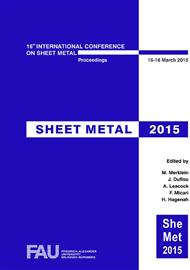p.339
p.347
p.353
p.361
p.369
p.377
p.385
p.395
p.403
Identification of Plasticity Model Parameters of the Heat-Affected Zone in Resistance Spot Welded Martensitic Boron Steel
Abstract:
A material model is developed that predicts the plastic behaviour of fully hardened 22MnB5 base material and the heat-affected zone (HAZ) material found around its corresponding resistance spot welds (RSWs). Main focus will be on an accurate representation of strain fields up to high strains, which is required for subsequent calibration of the fracture behaviour of both base material and HAZ. The plastic behaviour of the base material is calibrated using standard tensile tests and notched tensile tests and an inverse FEM optimization algorithm. The plastic behaviour of the HAZ material is characterized using a specially designed tensile specimen with a HAZ in the gage section. The exact location of the HAZ relative to the centre of the RSW is determined using microhardness measurements, which are also used for mapping of the material properties into an FE-model of the specimen. With the parameters of the base material known, and by assuming a linear relation between the hardness and the plasticity model parameters of base material and HAZ, the unknown HAZ parameters are determined using inverse FEM optimization. A coupon specimen with HAZ is used to validate the model at hand.
Info:
Periodical:
Pages:
369-376
Citation:
Online since:
March 2015
Keywords:
Price:
Сopyright:
© 2015 Trans Tech Publications Ltd. All Rights Reserved
Share:
Citation:


